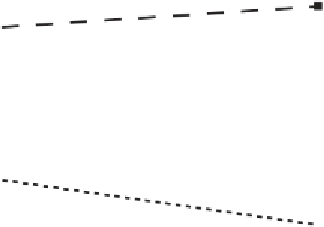Information Technology Reference
In-Depth Information
8
Democratic
Leadership
6
4
Laissez Faire
Leadership
2
Authoritarian
Leadership
0
Simple
Complex
Type of Projects
Figure 13.3
A plot of the two-way interaction.
within-subjects partitions separated in the computation. Following this
tradition, we have computed the eta squared values as follows:
Main effect of
A
:
SS
A
÷
SS
Between Subjects
Main effect of
B
:
SS
B
÷
SS
Within Subjects
Interaction
A
×
B
:
SS
A
×
B
÷
SS
Within Subjects
The plot of the interaction is shown in Figure 13.3. We will be in a
position to narrate these results once we have performed the simple effects
analyses.
13.4 COMPUTING THE OMNIBUS ANALYSIS BY HAND
The procedures for conducting a simple mixed factorial ANOVA parallel
many of the procedures covered previously in the between-subjects and
within-subjects factorial designs. We begin with the basic observations or
A
Subjects (
ABS
) data matrix found in Table 13.2. Recall that in
this study, the fifteen “cases” (designated
s
i
) are actually work teams that
are split into three independent groups that operate under three types of
leadership style (Factor
A
). This between-subjects factor has the follow-
ing three levels (
a
1
=
×
B
×
laissez faire).
Factor
B
, project type, is a within-subjects variable with two treatment con-
ditions (
b
1
=
authoritarian,
a
2
=
democratic,
a
3
=
complex). The dependent variable is a score
from 0 to 7 reflecting overall work team performance. The scores for each
subject within each (
AB
) treatment combination (in the
ABS
matrix)
simple,
b
2
=






